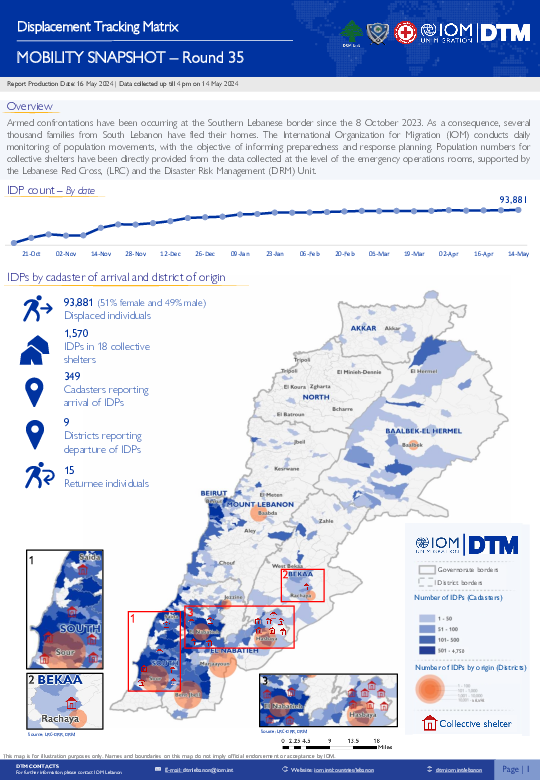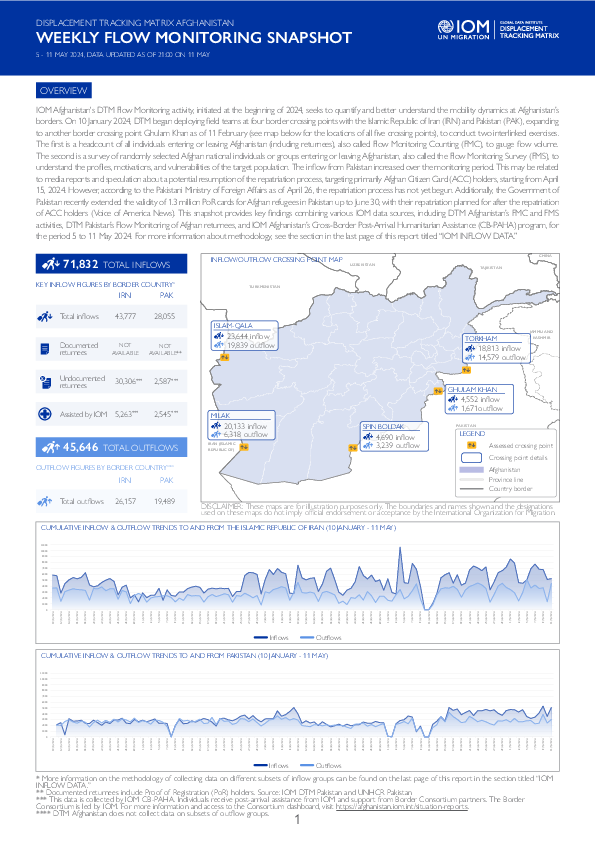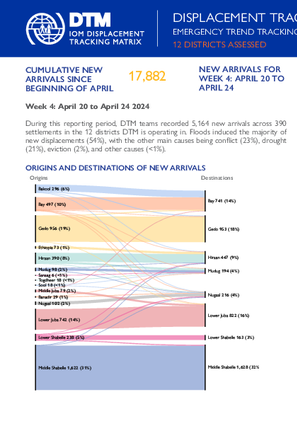-
Countries
-
Data and Analysis
-
Special Focus
-
Crisis Responses

Contact
DTM South Sudan, SouthSudanDTM@iom.int
Language
English
Location
South Sudan
Period Covered
Apr 01 2024
Apr 30 2024
Activity
- Registration
- Biometric Registration
Between 1 and 30 April 2024, IOM’s Displacement Tracking Matrix (DTM) interviewed 1,106 households representing 7,810 household members to assess the beneficiary satisfaction among service-receiving IDPs during distributions in Bentiu IDP Camp.
Contact
dtmlebanon@iom.int
Location
Lebanon
Activity
- Mobility Tracking
- Baseline Assessment
Period Covered
Oct 10 2023 -Mar 14 2024
Since October 8 there has been an increase in cross-border incidents between Israel and Lebanon, resulting in the displacement of people both within the South and elsewhere within the country. Since October 10, the Displacement Tracking Matrix (DTM) has been conducting the daily monitoring of population movements. The objective of the exercise is to inform preparedness and response planning.
Population Groups
IDPs
Survey Methodology
Unit of Analysis Or Observation
Admin Area 2
Admin Area 3
Household
Individual
Type of Survey or Assessment
Key Informant
Keywords
Geographical Scope Full Coverage
Administrative boundaries with available data
The current dataset covers the following administrative boundaries
May 16 2024
Print
Contact
DTM Ethiopia, DTMEthiopia@iom.int
Location
Ethiopia
Activity
- Mobility Tracking
- Village Assessment
Period Covered
Nov 23 2023 -Dec 31 2023
Between November and December 2023, IOM’s DTM deployed Site Assessment (SA) Round 35 and Village Assessment Survey (VAS) Round 18.
According to data collected through the Site Assessment round 35 November and December 2023, an estimated 3,194,413 IDPs (635,724 IDP households) were internally displaced across 2,662 assessed, accessible sites in Ethiopia. Conflict is the primary cause of displacement and displaced almost 2.2 million IDPs (68.7%), followed by drought which displaced an estimated 536,343 IDPs (16.8%). Somali region hosts the highest number of IDPs primarily displaced by drought nationwide (an estimated 391,573 individuals or 73% of the national drought caseload), while Tigray region hosts the highest number of IDPs primarily displaced by conflict nationwide (an estimated 831,002 individuals or 37.9% of the national conflict caseload).
Population Groups
Residents
Returnee (Previously Internally Displaced)
Survey Methodology
Unit of Analysis Or Observation
Admin Area 2
Admin Area 3
Admin Area 4
Community
Site or Location
Type of Survey or Assessment
Key Informant
Keywords
Geographical Scope
Administrative boundaries with available data
The current dataset covers the following administrative boundaries
Contact
DTM Ethiopia, DTMEthiopia@iom.int
Location
Ethiopia
Activity
- Mobility Tracking
- Site Assessment
Period Covered
Nov 23 2023 -Dec 31 2023
Between 23 November and 31 December 2023, IOM’s DTM deployed Site Assessment (SA) Round 35 and Village Assessment Survey (VAS) Round 18. SA is conducted in locations hosting a reported 20 or more IDP households, and the VAS is conducted in locations hosting a reported 20 or more returning IDP households that returned after 1 January 2022. It is to be noted that South Ethiopia region was not included due to operational constraints. Furthermore, the dataset for Amhara region is available separately, as a multisectoral location assessment was carried out within the region.
Population Groups
IDPs
Survey Methodology
Unit of Analysis Or Observation
Admin Area 2
Admin Area 3
Admin Area 4
Site
Type of Survey or Assessment
Key Informant
Keywords
Geographical Scope Partial Coverage
Administrative boundaries with available data
The current dataset covers the following administrative boundaries

Contact
DTM Ethiopia, DTMEthiopia@iom.int
Language
English
Location
Ethiopia
Period Covered
Nov 23 2023
Dec 31 2023
Activity
- Mobility Tracking
- Site Assessment
- Village Assessment
Between November and December 2023, IOM’s DTM deployed Site Assessment (SA) Round 35 and Village Assessment Survey (VAS) Round 18.
According to data collected through the Site Assessment round 35 November and December 2023, an estimated 3,194,413 IDPs (635,724 IDP households) were internally displaced across 2,662 assessed, accessible sites in Ethiopia. Conflict is the primary cause of displacement and displaced almost 2.2 million IDPs (68.7%), followed by drought which displaced an estimated 536,343 IDPs (16.8%). Somali region hosts the highest number of IDPs primarily displaced by drought nationwide (an estimated 391,573 individuals or 73% of the national drought caseload), while Tigray region hosts the highest number of IDPs primarily displaced by conflict nationwide (an estimated 831,002 individuals or 37.9% of the national conflict caseload).
According to the data collected through the Village Assessment Survey round 18 between November and December 2023, there were an estimated 2,548,685 returning IDPs (586,187 returning IDP households) across 2,580 assessed, accessible villages in Ethiopia. The highest returning IDP caseloads nationwide were in the regions of Tigray (967,257 returning IDPs, 38%), Amhara (an estimated 951,931 returning IDPs, 37.3%) and Afar (an estimated 222,179 returning IDPs, 8.7%).
It is to be noted that South Ethiopia region is not included due to operational constraints. Furthermore, the dataset for Amhara region is available separately, as a multisectoral location assessment was carried out within the region.

Contact
dtmlebanon@iom.int
Language
English
Location
Lebanon
Period Covered
Oct 10 2023
May 14 2024
Activity
- Mobility Tracking
- Baseline Assessment
Since October 8 there has been an increase in cross-border incidents between Israel and Lebanon, resulting in the displacement of people both within the South and elsewhere within the country. Since October 10, the Displacement Tracking Matrix (DTM) has been conducting the daily monitoring of population movements. The objective of the exercise is to inform preparedness and response planning.

Contact
DTMAfghanistan@iom.int
Language
English
Location
Afghanistan
Period Covered
May 05 2024
May 11 2024
Activity
- Survey
- Flow Monitoring Survey
- Flow Monitoring
IOM Afghanistan's DTM Flow Monitoring activity, initiated at the beginning of 2024, seeks to quantify and better understand the mobility dynamics at Afghanistan’s borders. On 10 January 2024, DTM began deploying field teams at four border crossing points with the Islamic Republic of Iran (IRN) and Pakistan (PAK), expanding to another border crossing point Ghulam Khan as of 11 February (see map below for the locations of all five crossing points), to conduct two interlinked exercises. The first is a headcount of all individuals entering or leaving Afghanistan (including returnees), also called Flow Monitoring Counting (FMC), to gauge flow volume. The second is a survey of randomly selected Afghan national individuals or groups entering or leaving Afghanistan, also called the Flow Monitoring Survey (FMS), to understand the profiles, motivations, and vulnerabilities of the target population. The inflow from Pakistan increased over the monitoring period. This may be related to media reports and speculation about a potential resumption of the repatriation process, targeting primarily Afghan Citizen Card (ACC) holders, starting from April 15, 2024. However, according to the Pakistani Ministry of Foreign Affairs as of April 26, the repatriation process has not yet begun. Additionally, the Government of Pakistan recently extended the validity of 1.3 million PoR cards for Afghan refugees in Pakistan up to June 30, with their repatriation planned for after the repatriation of ACC holders (Voice of America News). This snapshot provides key findings combining various IOM data sources, including DTM Afghanistan’s FMC and FMS activities, DTM Pakistan’s Flow Monitoring of Afghan returnees, and IOM Afghanistan’s Cross-Border Post-Arrival Humanitarian Assistance (CB-PAHA) program, for the period 5 to 11 May 2024. For more information about methodology, see the section in the last page of this report titled “IOM INFLOW DATA.”

Contact
DTM Somalia, IOMSomaliaDTM@iom.int
Language
English
Location
Somalia
Period Covered
Apr 20 2024
Apr 24 2024
Activity
- Mobility Tracking
- Baseline Assessment
This latest round of Emergency Trends Tracking was initiated in April 2024 to monitor displacements movements during the Gu rainy season. Districts covered in this round include Afgooye, Afmadow, Baardheere, Baidoa, Balcad, Belet Weyne, Gaalkacyo, Garoowe, Jamaame, Jowhar, Kismaayo, and Luuq.
ETT is a crisis-based tool that tracks sudden displacement triggered by specific events or emerging crises. The objective of ETT is to help prioritize humanitarian response and to enable partners to deliver rapid assistance. Based on previous shock induced displacement patterns, the humanitarian community expects that people will continue to move toward urban areas in search of humanitarian services. Consequently, the ETT coverage focuses on the main urban centers and surrounding villages for each assessed district. The data is collected through Key Informant Interviews (KIIs) at the location level, from Sunday to Wednesday every week. It includes information on new arrivals, numbers and demographic of IDPs, reasons for displacement, intentions, humanitarian assistance and priority needs among others.
This report presents the main findings from the Displacement Tracking Matrix (DTM) Flow Monitoring Surveys (FMS) deployed in Greece, Italy, and Spain in 2023. FMS provide a snapshot of the profiles, experiences, and needs of migrants. The survey asks questions on demographics, education and employment backgrounds, the circumstances of the migration journey and migration factors, as well as future intentions and vulnerabilities to abuse, exploitation and violence.
In 2023, a total of 4,020 surveys were collected in 130 entry and transit points for migrants arriving by land and by sea to Europe. The report explores similarities and differences among migrants travelling along the Eastern Mediterranean Route (EMR), the Central Mediterranean Route (CMR), the Western Mediterranean Route (WMR) and the Western African Atlantic Route (WAAR) (3,626 surveys). A separate section also looks at the evidence from migrants interviewed in the North of Italy, entering by land from Slovenia (394), connecting this with analyses carried out in the Western Balkan (WB) region. A final section addresses the conditions and needs of migrant children (14-17 years old) in the sample.
